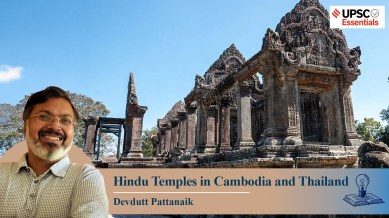Art and Culture with Devdutt Pattanaik | Cambodia-Thailand border temple that once knew no nations
One of the great cultural currents that travelled eastwards after the 7th century CE was the cult of Shiva, which played a pivotal role in the rise of the great Shaiva temples of India and Southeast Asia. The temple on the Cambodia-Thailand border is part of this tradition.

The recent skirmish between Cambodia and Thailand caught Indian attention not because of Buddhist politics but because the fight was over a Hindu temple perched on the border of two Buddhist nations. The temple, known as Preah Vihear, is a grand Shaiva temple built between the 9th and 12th centuries on a clifftop in the Dangrek Mountains.
For over two thousand years, monsoon winds shaped the rhythm of trade. Ships from Arabia and Africa came to India’s western coast before the rains, and returned after the monsoon had passed. On the eastern coast, ships sailed before the monsoon towards the lands we now call Myanmar, Thailand, Cambodia, Vietnam, and Indonesia, and came back once the winds reversed. Cotton textiles from India flowed east, and in return came gold, rubies, sapphires, spices, and fragrant woods that dazzled Indian courts.
Spread of cultural currents through river and sea
As early as the 3rd century CE, Chinese records speak of Indian merchants, dancers, and scribes in the Mekong delta, the land then known as Funan. Stories are told of an Indian named Kauṇḍinya who married a Naga princess and brought with him the Indian way of living – its rituals, writing, and cosmology. Funan became a major hub, linking inland Mekong trade to the sea.
Such hubs arose wherever rivers met the ocean: the Mahanadi delta of Kalinga, the Godavari and Krishna deltas of Andhra, the Cauvery and Vaigai of Tamil Nadu, the rivers of Sri Lanka, Burma, Thailand, and Java. River mouths became cultural cauldrons where goods, stories, and gods exchanged hands.
One of the great ideas that travelled eastwards after the 7th century was the cult of Shiva. This was the great Shaiva age – from the 7th to the 12th centuries – when Shaiva gurus taught kings that Shiva’s power could be invoked in the body of the king himself. A king infused with Shiva-tattva was said to command the rains, charm the people, attract talent to his court, and strike fear into enemies. He would become the axis around which a mandala kingdom arose – a world of prosperity, music, dance, and abundance.
But for this to happen, elaborate rituals had to be performed as described in the Shaiva Agamas – texts that claimed to reveal secrets even the Vedic Brahmins had forgotten. These rituals required sacred precincts, and thus arose the great Shaiva temples of India and South-East Asia. We see Prambanan in Java, the shrines of My Son in Vietnam, and the grand Angkor complex in Cambodia.
Some temples installed Vishnu images instead of Shiva, for the two deities were seen as complementary forces – Harihara images, half Vishnu and half Shiva, became popular both in Odisha and in South-East Asia.
Cult of Shiva and Preah Vihear temple
The temple on the Cambodia-Thailand border is part of this tradition. Built on a mountain, it was not a bhakti temple where ordinary people came for darshan. It was a royal ritual centre, where kings performed ceremonies to activate their divine aura and transform their kingdom into a cosmic paradise.
This was the theatre state, a polity where kingship depended less on war or welfare and more on performance – performances timed to the rhythm of the monsoon, mirroring sowing and harvest cycles, ensuring prosperity. Through these rites, the king transformed himself into Indra, the king of heaven, ruling a garden of delight, swarga, on earth.
This was not feudalism. The king was not just a landlord but a god-king or Dev-raja, holding together nature and culture. This idea seeped even into Buddhism, giving birth to tantric forms of Buddhism that spread not only to Cambodia and Java but also to Tibet.
Thus, the temple fought over by Cambodia and Thailand is a fossil of a time when kings sought not just power but cosmic legitimacy, when monsoon trade brought Indian gods to distant shores, and when kings dreamed of making their kingdom not just rich but radiant, a paradise on earth.
There were no borders or nation-states when these temples were built. There was no Cambodia or Thailand then. But today sanctuaries of old gods and their royal patrons are tourist attractions as well as matters of pride. The resulting economic and political tensions result in wars. It has nothing to do with the faith of people.
Post read questions
What role did monsoon winds play in shaping trade and cultural exchange between India and Southeast Asia?
What does the spread of the Śaiva and Tantric traditions tell us about the cultural interactions between India and Southeast Asia?
What does the term “theatre state” mean, and how does it describe the functioning of Southeast Asian polities?
In what ways do ancient monuments like Preah Vihear continue to shape modern political identities and conflicts?
(Devdutt Pattanaik is a renowned mythologist who writes on art, culture and heritage.)
Share your thoughts and ideas on UPSC Special articles with ashiya.parveen@indianexpress.com.
Subscribe to our UPSC newsletter and stay updated with the news cues from the past week.
Stay updated with the latest UPSC articles by joining our Telegram channel – IndianExpress UPSC Hub, and follow us on Instagram and X.